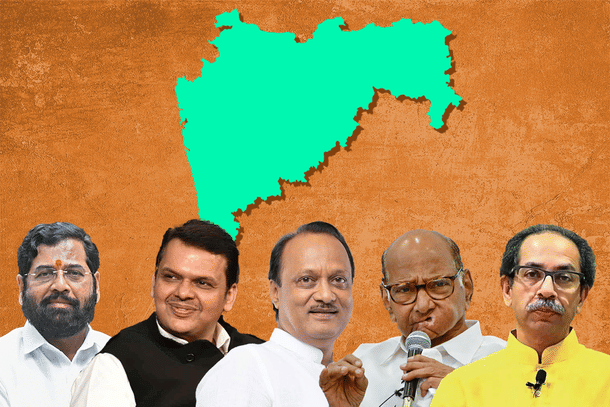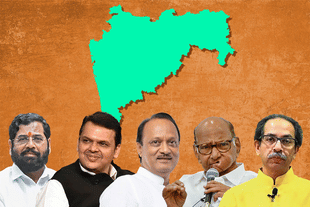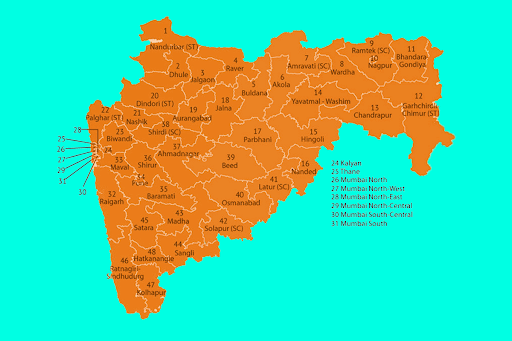Politics
Maharashtra: The Political Drama And Maha Yuti's Prospects In 2024 — A Region-Wise Analysis
Diksha Yadav
Apr 11, 2024, 12:47 PM | Updated 04:29 PM IST
Save & read from anywhere!
Bookmark stories for easy access on any device or the Swarajya app.


Maharashtra has the second most number of Lok Sabha seats. Maharashtra's political landscape has turned interesting, but it is quite confusing at the same time because of the following reasons:
- The political instability over the past few years,
- the two major parties (Shiv Sena and NCP) splitting into two factions each,
- and the infighting between the new alliances and candidates switching sides even with only a few days left for the first phase of general elections over ticket distribution.
In addition to this, amidst all the political drama in the state, this is the first time all the parties in the state will be facing elections since 2019.
In the last five years, there has not been a single election in the state. The municipal elections have not taken place. The 25 years of enemies have become friends, and friends have become enemies. And even within friends, even between new alliances, there is infighting because of the ticket distribution, said Anay Joglekar in Diksha Yadav's podcast What This Means. You can listen here on Spotify or the Swarajya app.
In this episode, the host, along with Banuchandar Nagarajan, discussed all that has happened, is happening, and not happening in Maharashtra with Anay Joglekar. Below is an edited transcript, focusing on the region-wise analysis of Lok Sabha seats and Maha Yuti's prospects ahead of the 2024 general elections.

1. Mumbai - Earlier a Shiv Sena Stronghold
Mumbai was largely a bastion of the Shiv Sena. This is the place where Shiv Sena was born. Shiv Sena really grew up, and Shiv Sena had a very strong organisation in Mumbai. In every other household in Mumbai, especially the 40 per cent of people who are living in slums or in chauls, the Shiv Sena had a very strong grassroots network.
So, Shiv Sena's real core strength was Mumbai, and they used to contest elections mostly in the boroughs where the population of Marathi-speaking people was high.
Mumbai region was distributed between the Shiv Sena and the BJP:
- In municipal elections, the Shiv Sena used to get a really big chunk because they used to rule the municipality.
- In assembly elections, they were more or less equal, where Shiv Sena was influential in mostly Marathi-speaking areas, and the BJP in Gujarati and non-Marathi-speaking areas.
- In the Lok Sabha, Mumbai had three seats. Among them, Shiv Sena typically contested in areas with blue-collar communities, including chawls and slums.
However, Shiv Sena is split now, with 40 MLAs siding with Eknath Shinde. Shiv Sena's real life or power was in the Mumbai Municipal Corporation — which had an annual budget of more than 50,000 crore rupees, However, Shinde's faction of Shiv Sena lacks a robust presence there, and that's why the BJP wants to contest at least four or five seats there.
It is also an emotional issue because for Shinde to go to his people and say, look, we used to rule Mumbai, and from there, we are going to contest only one or two seats. Then it would be very difficult for him to sell this Shiv Sena-BJP alliance to its people. That's why they have not announced many seats here, it will be announced only at the last moment. But I believe that here the BJP, Shiv Sena, and NCP of Maha Yuti have an understanding.
2. Konkan - Why Seat Sharing in Maha Yuti is Difficult
Earlier, Mumbai and Konkan were both Shiv Sena bastions. But from Konkan, in the last 15-20 years, especially since the NCP was born in the late 1990s, Sharad Pawar put a lot of emphasis in taking people out of the Konkan region and adding them to the NCP party. Also, the changing demographic helped because there was a lot of migration from Konkan, which created a population imbalance.
There is now a significant population of Muslims in the Konkan region. So NCP gained quite a ground in Konkan, and Shiv Sena became weak.
In 2014, when Devendra Fadnavis became Chief Minister of Maharashtra, BJP was almost non-existent in Konkan. So Fadnavis tried the same strategy. He started poaching leaders who were with Shiv Sena but who had gone to Congress, like Narayan Rane or other leaders in Panvel in the Northern Konkan, Ganesh Naik in Thane, and Kapil Patil, for example. So he started taking people mostly from the NCP and some from Shiv Sena and Congress as well.
Today in Konkan, the BJP is almost as strong as the Shiv Sena. And that's why Konkan is also very tight because it's like a home ground for Shiv Sena, and giving up seats to the BJP is quite insulting to them.
In Konkan, especially the seats like Ratnagiri Sindhudurg, where Union Minister Narayan Rane wants to contest, that seat belongs to Shiv Sena, but the BJP wants it. Other seats, like Raigad, where the NCP won last time, but that was again with Shiv Sena for many years. So that's why tensions quite exist. In the Konkan region, the traditional fight was between Shiv Sena and the NCP, and now both are together. Therefore, seat distribution has become quite tricky in this region.
3. Northern Konkan - Thane, Palghar and the Kalyan Seat
Traditionally, Konkan was the coastal belt, which was largely involved in seasonal agriculture, paddy agriculture, horticulture, mango, and other fruits. It was very poor, but it was a very self-respecting kind of region.
However, in the last 15 to 20 years, as Maharashtra has more than 50 per cent urban population now, most of this urban population has been saturated between Mumbai, Pune, and Nasik. So the Northern Konkan is fully urbanised, and there the non-Maharashtrian population, or migrant population, has increased significantly.
On the one hand, the Marathi-speaking population has migrated out of Mumbai into the suburbs, that is, the Thane district or Palghar district.
Whereas, a large migrant population, largely from north India but also from all across India, has come to Mumbai, and those who could not settle in Mumbai have settled in suburbs and satellite towns. That is why the demographics have changed significantly.
Thane and Palghar districts were the bastions of Eknath Shinde, who sees himself as a successor of Anand Dighe (Dighe was a charismatic leader and had built the organisation of Shiv Sena in Thane and Palghar), and he wants to continue with that.
But, like I said, in the last 15-20 years, NCP started poaching Shiv Sena and created its own pockets within the Thane and Palghar districts. And then BJP started poaching NCP, and now many of these people who were in Shiv Sena went to NCP, and from NCP they joined the BJP. So in Thane and Palghar districts, too, BJP and Shiv Sena are on equal footing.
Even though BJP and Shiv Sena are alliance partners in the state, it is quite tense in Thane and Palghar, especially the Kalyan seat, where the BJP has a stronger presence, but the Lok Sabha seat has been given to Shiv Sena. So there are claims and counterclaims between Shiv Sena and BJP, and that's why the seats have not been decided yet.
4. Northern Maharashtra - The Nashik Seat
In Northern Maharashtra, some parts come under the tribal belt: Dule, Nandurbar, and others. This region is quite settled for the Maha Yuti alliance. However, the interesting seat in this region is Nashik.
This stems from Nashik's historical significance as a stronghold for Shiv Sena. Chaggan Bhujbal, once a prominent leader within Shiv Sena, transitioned to Congress and then to the NCP. He established his base in the Nasik district, particularly in rural areas. In recent times, the BJP has also gained substantial influence in the region. Despite Shiv Sena being allocated the Lok Sabha seat within the Maha Yuti alliance, the BJP and NCP hold stronger positions in Nashik.
I think it's a pressure tactic. Maybe the BJP, in the end, will cede a couple of seats and gain a couple of seats in other regions. So it's suspenseful, but let's wait for the last date of filing the forms.
You have to understand that in this region of Maharashtra, the population is decreasing, so the region is big, but unlike Mumbai and Thane, where there is a large population and almost 60 seats out of 288 assembly seats, the population here is less and has very few seats. So the region is important, but it never becomes the epicentre of Maharashtra politics as Western Maharashtra, Mumbai, or Pune do.
5. Vidarbha - Chandrapur and Amravati
The Eastern Vidarbha was a Congress bastion. But the BJP gained ground in the Vidarbha region, both in East and West Vidarbha. Nitin Gadkari, Devendra Fadnavis, Sudhir Mungantiwar, and many other big leaders of the BJP come from the Vidarbha region.
In the 2014 Lok Sabha as well as the assembly elections, Vidarbha played a big role for the BJP. In Western Vidarbha, Shiv Sena is strong in certain pockets, like Yavatmal and in some parts Congress is strong. But Congress is now losing a lot of ground, and last time, too, they won only one seat, Chandrapur.
That was also accidental because they won with a candidate they took in from Shiv Sena — Suresh Dhanorkar — he was like a giant killer. But Congress is getting organically weak now, especially since it does not have the wherewithal to fight elections against the BJP in the Vidarbha region. So Vidarbha is quite settled for Maha Yuti.
However, only the Amravati seat — which was a difficult seat for the BJP and was also lost last time — is tough. Here's why:
- A court case about caste is going on Navneet Rana, BJP's candidate for the Amravati seat.
- It has been a tough seat for the BJP to crack.
Last time, Amravati was won by Navneet Rana, then an independent candidate (now in BJP). She was supported by the NCP in 2019 LS elections. In 2014, Shiv Sena won this seat.
There is an issue with Rana's caste because she is a Punjabi and her husband belongs to the Dalit community, so it is believed that she manipulated her caste certificate and the result of that case is still not out.
BJP found her formidable because when the government changed in the state, their loyalty changed, and she became a very strong supporter of PM Modi and Devendra Fadnavis, she took on Uddhav Thackeray when he was chief minister. That's why I think the BJP has given her the ticket.
6. Marathawada - The Muslim Population and the Maratha Protests
Marathwada is like Telangana, which was like a part of Nizam territory. It was extremely backward because, during Nizam's rule, they didn't develop the region. Also, though Maharashtra has the highest number of irrigation projects, but that is mostly in Western Maharashtra, so the farmers are relatively better there.
Marathwada is largely agrarian. It is extremely poor. There is no irrigation. And because of the shortage of water and electricity, there are no significant industries, except for some pockets. There are four factors to consider here:
- The Muslim population in this region is increasing very fast in certain parts, they have even joined terrorist organisations in the past, and so that is a cause of concern.
- Marathas who are not the elite marathas, which are mostly agrarian marathas in this region, are restless because of the continuous agriculture crisis, and no change in the last 10 years.
- The Dalit politics is also very strong in certain regions here.
- The OBC population is large here. The BJP has few leaders here like Gopinath Munde, who used to come from Beed. Now his legacy is, in a way, with Pankaja Munde and her sister, Pritam Munde.
Marathwada was recently in the news because a large section of the Maratha community started the agitation. They want the status of a backward caste. They claimed that Marathwada was part of Nizam rule. Under Nizam rule, the Marathas were considered backward. So that is the reason they should be considered backward.
Initially it was only the people who had these land revenue records, then they started saying the entire community should get it, then they started saying the entire Maratha community in Maharashtra should get it, but because there was restlessness, it caused a huge protest.
And then these protests became anti-Devendra Fadnavis protests. The leader of the Maratha community in the protest, Manoj Jarangye Patil, started targeting Fadnavis, saying that because he's a Brahmin, he is responsible for Marathas not getting reservations, and it is a very highly emotional and political issue. That's why a lot of people are sceptical about what will happen because if it's a swing factor in Marathwada, it can damage the BJP to some extent.
However, now that the electoral winds are blowing and the issues have changed, I believe that this factor will have limited damage. Though the BJP is on a little weak turf here, it has taken people like Ashok Chavan, who was with Congress and was also two times chief minister of the state. Therefore, I believe it will help the BJP to a certain extent.
7. Western Maharashtra - Baramati, Kolhapur, Satara
Western Maharashtra was a bastion of the NCP. Because, from here, all the sugar barons and education barons come. These are electable people who can get elected from any region, and so NCP was going strong for 15-20 years in this region.
However, BJP's smart politics — especially of Fadnavis, of using development and also the threat of investigating agencies because all these people were cooperative barons — many of them had troubles (like alleged scams or such issues). So a lot of people came to the BJP, and with Ajit Pawar breaking from the NCP and joining the Maha Yuti, I feel that the NCP - Sharad Pawar faction - has lost his spirit to fight.
There are some pockets with a very strong politics of hatred like anti-Brahmin politics. In such pockets, Sharad Pawar can play some role because he is giving tickets to people who are associated with caste politics. He is very clever because he has lost his ability to control the organisation and the economic resources.
That's why he is choosing people who are like mavericks, who are not typical politicians, but who are faces of agitation against the BJP or Brahminism. So let's see how it plays, but it looks like it will not have a lot of impact.
The Baramati seat is the most important one where the two women from the Pawar family are contesting against each other: Supriya Sule versus Sunitra Pawar, wife of Ajit Pawar.
Last time, Supriya Sule won by only a margin of about one lakh votes in Lok Sabha, and in 2014, it was even less than lakh votes, but Ajit Pawar in the Baramati assembly seat, which is like one of the six seats, won with a margin of more than four lakh votes.
So now Ajit Pawar is siding with the BJP, and his wife is contesting Baramati. This will be the seat to be watched for in Western Maharashtra.
Kolhapur — The ruling family was split into two. The rulers, as it is said, are heirs of Chhatrapati Shivaji Maharaj. The seat is split between Satara and Kolhapur, with Satara being a more important seat. In Kolhapur, Congress has given a ticket to the other family - Shahu Chhatrapati.
Satara — Chhatrapati Udayanraje Bhosale is with the BJP. Bhosale served in the legislative assembly (1998-1999) and as Maharashtra's Revenue Minister in the Sena-BJP government. He was elected to the Lok Sabha in 2009, 2014, and 2019 as an NCP candidate from Satara, but he rejoined the BJP in 2019.
There was a by-election, and Sharad Pawar caused the defeat of Bhosale. Then the BJP sent him to the Rajya Sabha. Now he is interested in contesting the seat from Satara again. We have to see what the BJP does now.
These are seats that will be interesting to watch out for in Maharashtra:
South Mumbai
Kolhapur
Baramati
Satara
Amravati
Aurangabad
P.S. We also discuss other factors like the impact of Vanchit Bahujan Aghadi going solo, the infighting and party hopping in the alliances — what people in Maharashtra think and more ahead of the 2024 general election. Listen to the full episode here: 🎙️𝟮𝟬𝟮𝟰—𝗠𝗮𝗵𝗮𝗿𝗮𝘀𝗵𝘁𝗿𝗮 𝗣𝗼𝗹𝗶𝘁𝗶𝗰𝘀 𝟭𝟬𝟭





